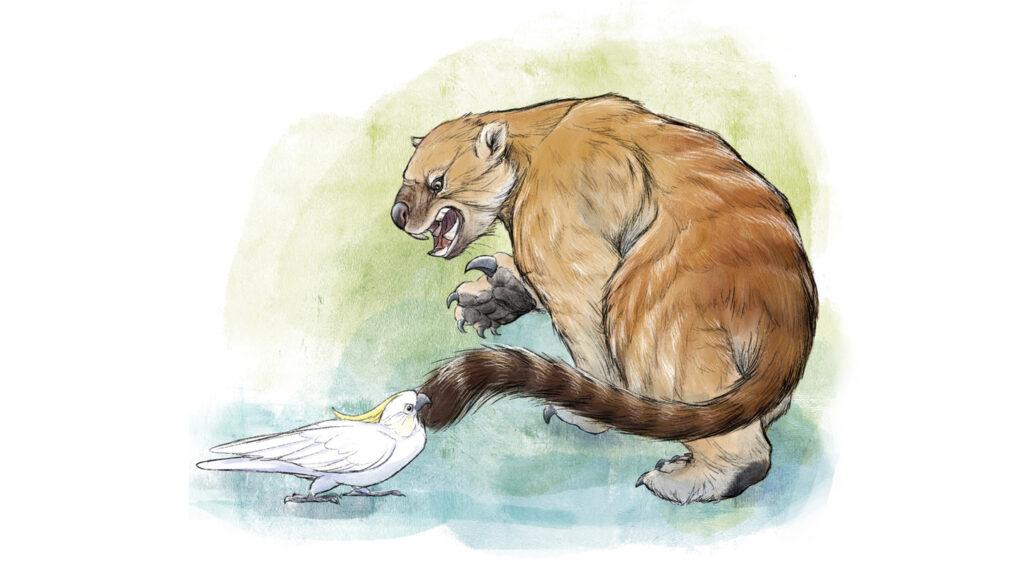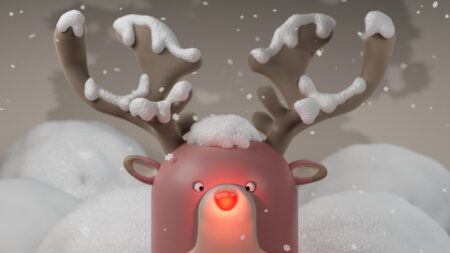The koalas clambering around eucalyptus canopies may be cuddly herbivores, but their extinct relatives were horrifying predators.
The charismatic marsupials are the closest living relatives of marsupial lions — powerful carnivores that went extinct around 40,000 years ago. The findings are part of a study published November 12 in Proceedings B of the Royal Society that used durable proteins preserved in bones to reveal the evolutionary relationships of five strange, extinct Australian marsupials.
Until tens of thousands of years ago, Australia and nearby landmasses were home to a variety of large marsupial mammals. Unlike placental mammals, marsupials give birth to relatively small, underdeveloped young that are carried and nursed inside a pouch. The ancient marsupials included enormous wombatlike creatures like Zygomaturus trilobus — kangaroos twice the size of adult humans — and cow-sized, tapirlike herbivores such as Palorchestes azael.
But shortly after humans arrived on the continent, these mammals and many others went extinct. By around 46,000 years ago, some 90 percent of land animals heftier than roughly 40 kilograms had vanished, leaving only bones. Researchers have used the shapes of these bones to reconstruct the species’ positions in the marsupial family tree, though many details have been the subject of ongoing debate.
“Before this [new] work, the relationships between these animals were unclear, with several different possibilities proposed by various researchers,” says Michael Buckley, a biomolecular archaeologist at the University of Manchester in England.
While ancient DNA is useful for building evolutionary trees, it degrades over time. Scientists can also use collagen, a ubiquitous protein in the body that provides structural support. Collagen is more durable than DNA and, like DNA, it varies between species, allowing researchers to create a kind of species fingerprint.
Buckley and colleagues in Australia sampled 51 marsupial bones from seven sites across Tasmania, dating from a few thousand to over 100,000 years ago. The bones belonged to eight species of extinct and living marsupials. The team extracted collagen and compared amino acid sequences with those of living species to construct a marsupial evolutionary tree. For Z. trilobus, P. azael and the extinct, predatory “marsupial lion” Thylacoleo carnifex, the study provides the first biomolecular insights into their ancestry.
Some findings align with studies that develop evolutionary trees from examinations of fossil bones. For instance, Zygomaturus and Palorchestes appear to branch off from modern wombats and koalas. Previous fossil studies indicted their upper molar shapes were most similar to each other and that they both lacked openings in their palates, unlike other marsupial groups.
But Thylacoleo — the marsupial lion — provided a fascinating curveball, says Michael Archer, a paleontologist at the University of New South Wales in Sydney.
“We’ve been chasing the evolution of marsupial lions,” he says. “[The researchers are] saying it most closely matches koalas as opposed to wombats. So that’s a surprise.” Most researchers thought Thylacoleo was closer to wombats or outside both marsupial groups, based on skull and tooth features. But it seems koalas and marsupial lions shared a common ancestor as recently as 23 million years ago.
Thylacoleo could reach the size of a modern lion and had a powerful bite that snapped bladelike teeth past each other, turning the animal’s jaws into biological bolt cutters. But there are some notable similarities with koalas.
“Anybody who’s actually cuddled a koala knows they are not nice animals,” Archer says. They have gripping claws that can cause severe lacerations. Similarly, the tree-dwelling Thylacoleo was armed with huge, curved claws on its thumbs. “When they grabbed prey and moved their hand around it, they would have unzipped the prey like a hot sausage.”
In a twist, the findings lend credence to the Australian folk hoax of the “drop bear,” a ferocious, carnivorous variety of koala said to fall upon its victims from the canopy. Paleontologists think Thylacoleo was an adept climber and ambush predator that could dive upon its prey from tree branches or rock outcroppings. “We actually have evidence here that Australian drop bears are not something that we dreamed up in a weird nightmare,” Archer says.
Tasmania’s cool climate may have partly made this study possible, since collagen in remains breaks down faster in hot environments.
“I do wonder how well [the methods] will work in the more tropical, more arid regions of Australia,” says Carli Peters, a zooarchaeologist at the University of Algarve in Portugal. She wonders if the approach could be used on remains of Diprotodon, a rhino-sized herbivore that was the largest marsupial ever.
Buckley expects that ancient protein sequences can and will be used to better understand the evolution of “a wide range of other extinct animals.”
Read the full article here














